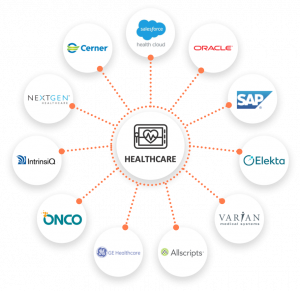Healthcare IT Integration Market Challenges and How to Overcome Them?
Integration of Health (IT) Information Technology Market
Health information technology (IT) integration into primary care encompasses a wide range of computerised systems for managing information about people’s health and health care, for both individual patients and groups of patients. Health information technology can increase the quality of care while also lowering costs.
The following are some instances of health IT in primary care:
- Clinical decision-making assistance.
- Disease registries that are kept on computers.
- Order entry by a computerised supplier.
- Applications for consumer health information technology.
- Systems for electronic medical records (EMRs, EHRs, and PHRs).
- Prescriptions are written in an electronic format.
- Telehealth.

What Is the Importance of Health IT?
Through the secure use and sharing of health information, health IT allows health care practitioners to better manage patient care. Health IT can improve the quality of care while also lowering costs by providing secure and private electronic health records for the majority of Americans and making health information available electronically when and where it is required.
Health care practitioners will be able to do the following with the help of health IT:
Information regarding a patient’s health that is accurate and full. That way, whether it’s a normal visit or a medical emergency, physicians can deliver the best possible care.
The ability to more effectively coordinate the care provided. If a patient has a critical medical condition, this is extremely important.
For patients who prefer this convenience, a means to safely communicate information with their family caregivers over the Internet. As a result, patients and their families will have a greater say in health-care decisions.
Information to aid in the early detection of health concerns, the reduction of medical errors, and the provision of safer care at cheaper costs.
What is the definition of data integration?
Clinical data integration is the process of combining data from several healthcare sources into a unified format. It eliminates unstructured data by utilising components such as healthcare data sources and a master server. The healthcare industry has challenges with health integration platforms and structured data management. Consider the who, what, when, where, and how of the data to understand structured vs. unstructured data. Patients receive the highest quality care through integrated health.
In healthcare, there is a pressing need for EHR integration.
Healthcare workers are under a lot of stress and are strained for time. They are concerned with the upkeep of healthcare organisations, personnel, and improved patient care. For healthcare providers, administrative responsibilities and advanced paper work become burdensome.
Unstructured data is a challenge for healthcare workers. That is why, in order to improve the efficiency of the managed care continuum, a healthcare automation solution is required. Using software-based health informatics, an integrated healthcare information system assigns patients to different primary care physicians. Patients can obtain care from numerous healthcare data sources because to EHR integration. Integrated health aims to handle a patient’s many health concerns from a single point of contact and give the best care plan possible. In addition, there are a number of advantages to data integration in healthcare:
Tools to Overcome Healthcare IT Integration Market Challenges
In the healthcare integration process, a data integration tool is used on the data source to transmit the data to the destination. These tools are used for data cleansing, transformation, and mapping. Choosing the right tool for your medical service can be difficult, but choose what best meets your needs. Choose tools that assist better-integrated health care based on aspects such as data sources.
On-premises: These technologies are ideal for combining data from a variety of local or on-premise data sources. They’re set up in a private cloud or a private network. These utilities provide native connectors that are tuned for batch loading from a variety of well-known data sources. They do, however, necessitate a significant capital investment in hardware and infrastructure. Larger or legacy healthcare systems are examples of on-premise data sources. IBM InfoSphere, Microsoft SQL, and Oracle Data Service Integrator are some examples of these products.
Integration platforms as a service (IaaS):
Many cloud-based solutions are integration platforms as a service (IaaS) (iPaaS). They use healthcare integration systems to merge data from diverse sources. These services are built to work with current, web-based streaming data sources as well as traditional databases. Alooma, Jitterbit, and Oracle Integration Cloud Service are some of the most regularly utilised cloud-based solutions.
If you want to avoid utilising proprietary and pricey business integrated healthcare solutions, open-source software may be your best alternative. It’s also appropriate if you want complete control over your data in-house. Some popular open-source data integration tools are CloverETL, Karma, Myddleware, and Pimcore.
The main difference between these and open-source data tools is the fee. They’re also frequently created for unique commercial needs. This is one of the most dependable and stable tools available.
Patient data is created in all departments and at all points of service throughout the healthcare business, making it highly information-intensive. However, in order to create comprehensive and reliable patient records, it is important to generate credible information by integrating huge amounts of data.
Because healthcare systems use a variety of medical devices and diagnostic tools, there is an increasing need to connect all of these systems to help healthcare workers provide rapid responses at multiple care delivery points. As more healthcare organisations implement various healthcare IT systems, there is a rising need to integrate various types of IT systems into the organization’s IT architecture to guarantee that these systems are used to their full potential and aid in correct decision-making. Healthcare IT infrastructure development initiatives prioritise the successful integration of healthcare IT systems with other systems.
With multiple significant rivals, the healthcare IT integration sector is tremendously competitive. Mid-size to smaller enterprises, on the other hand, are strengthening their market position by introducing new ingredients at reduced rates, thanks to technological advancements and product breakthroughs.
The market is dominated by Allscripts Healthcare Solutions Inc., Cerner Corporation, GE Healthcare, and IBM Corporation.
Zion Market Research offers in-depth qualitative insights, historical data, and reliable market size predictions. The report’s estimates are based on well-established research methodology and assumptions.
View the report’s summary and complete Table of Contents (ToC)
The Top 5 Challenges to Healthcare IT Integration Market
Healthcare integration was created in order to better serve patients and provide high-quality care. However, there are some healthcare integration obstacles you should be aware of, the top five of which are listed below.
1. Interoperability Issues with EHRs:
Structured data is pulled into a data lake using new data integration technology. Data collection and integration must adhere to HIPAA compliance guidelines. Healthcare integration is being implemented by a number of healthcare institutions. This necessitates a wide range of data types and sizes. When implementing healthcare integration, keep in mind that one of the biggest obstacles in healthcare is healthcare interoperability. You don’t want to end up with data silos because of interoperability. Healthcare interoperability might be hampered by a lack of data standardisation. As a result, it’s critical to agree on a single format and convert data to it.
2. Health Data Privacy:
When it comes to healthcare integration, privacy and compliance might be big considerations. Some healthcare organisations recognise the need of data security. Data sharing has the potential to compromise security and allow access from unwelcome parties. Cloud computing is becoming more popular in healthcare to avoid data silos and confusion. As a result, rigorous governance is required to assure security. Database administrators are granted permission by data governance. It allows you to access specific data for a set period of time. You are also complying with HIPAA regulations by allowing others to examine and evaluate the data.
3. HL7 Interoperability
The HL7 interface is used to convert data into an understandable format. Healthcare professionals and software vendors may face difficulties as a result of this integration method. Doctors are unable to collaborate with software vendors due to their busy schedules. As a result, IT departments are dealing with overabundances in healthcare integration. This means that their relationships with healthcare organisations may be stalled for a long time. It may be tough for the IT team to assemble the key interfaces in accordance with HL7 standards. Furthermore, it can mislead if the HL7 integration semantics are inadequate. It’s possible that switching to a new EHR would result in the loss of some earlier data, such as a patient’s medical history.
4. Inconsistency in the data
Data must be consistent while implementing an integrated healthcare system. However, healthcare companies may have different preferences when it comes to user apps. This might lead to data inconsistency, compromising data quality and the integrated care delivery paradigm.
5. The end-user
Using integrated data benefits patients, doctors, and nurses. It provides integrated patient care while also improving the patient experience. Healthcare data is a valuable resource, but it is challenging to evaluate raw data.
